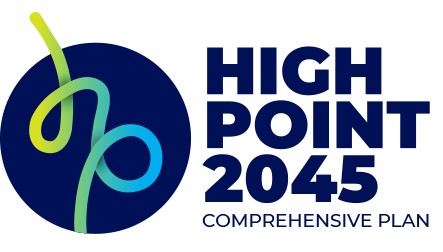2. Initiate a multifaceted approach to diversifying housing throughout the city
Strategy Actions
High interest rates and low supply has driven up the cost of housing across America. As mortgage rates continue to stabilize, prices are likely to follow as the inventory increases. How much is yet to be determined. What is true regardless of mortgage rates, is that housing diversity is healthy no matter what the interest rates are doing. However, it’s often difficult to expand housing diversity, especially in higher income areas.
It’s often the case that residents of predominantly single-family neighborhoods fear that changes that increase housing diversity will negatively impact their property values because they fear that new residents will be lower-income. However, according to research by Brookings and others, neighborhoods with diverse housing do not have substantially lower household incomes than exclusively single-family neighborhoods. In addition, research has always shown that multi-family development, including workforce housing, does not necessarily negatively affect property values. In some cases, land values have increased due to the capitalization of new development potential.
High Point currently allows accessory-dwelling units (ADUs), which is a step in the right direction, and missing-middle housing in the Core City area. However, it will likely take progress on multiple fronts to diversify housing and expand opportunity for everyone. Efforts should be taken to ensure existing residents are not displaced as housing is directed to the downtown area and the activity centers.
Higher density developments offer a significant return on investment for the development community that increases the city’s tax base and creates an economy of scale that allows for various access points for future householders.
Tools to consider include but are not limited to:
Allow missing-middle housing outside of Core City area.
In addition to ADUs, which are permitted as an accessory unit on single-family lots in all residential districts, High Point should consider expanding opportunities for the development of duplexes, triplexes and quadplexes in residential districts throughout the City. Currently, these types of buildings are only permitted in the Core City area. At a minimum, consider duplexes in all residential districts that permit single-family.
Consider an inclusionary housing program.
Most of the effort to understand affordable housing in High Point has been focused on the Core City neighborhoods. However, housing affordability is important to people throughout the City. The City should look to better understand through studies and/or working with local housing stakeholders, the local housing market. Following this effort, consideration should be given to both a voluntary and required inclusionary housing program with the goal of expanding opportunities for people of all incomes to live in geographies throughout the City.
Reduce or even eliminate parking requirements.
It costs more than $5,000 to build each surface parking space and more than $20,000 for each parking garage space. Parking is often over supplied leading to unnecessary impervious surfaces and costs and consuming land that could be used for additional housing. Allowing developers to right-size parking could lead them to build more units and repurpose underutilized buildings for housing. This could be especially helpful to stimulate neighborhood revitalization in the Core City.
Build more rental housing near transit stops.
Many people that are dependent on bus service as their primary means to get places, are also renters. Building missing middle housing and apartment buildings within walking and biking distance to major transit stops will better service High Point residents. This will likely require incentives and working closely with developers to move this forward in neighborhoods in and outside of the Core City. Expanding the geographical reach and hours for the existing transit system and/or offering micro-transit options could better serve those neighborhoods where auto ownership is low. Transit stops should also be incorporated into activity centers as they develop.
All of these tools must be coordinated with an update to the development ordinance and other land use and community development policies.




Implementation Timeline for this Strategic Initiative
Success Measures
Target Year/Range
Development Ordinance update includes an expansion of missing-middle housing options
2027
The parameters of an inclusionary housing program are outlined, including possible funding sources
2032
Strategic Initiatives for this Priority
Strategic initiatives refer to carefully planned actions or projects that the city will need to undertake to achieve this plan’s desired outcomes for each of the Big Things.
Learn more about these and other Strategic Initiatives in Our Way Forward
